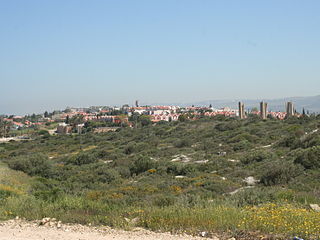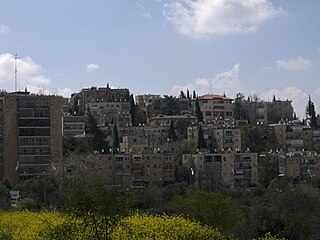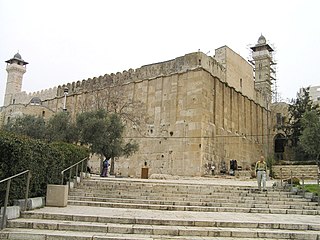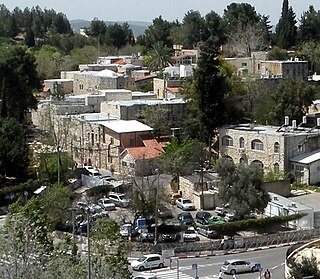
Marble is a metamorphic rock consisting of carbonate minerals (most commonly calcite (CaCO3) or dolomite (CaMg(CO3)2) that have recrystallized under the influence of heat and pressure. It has a crystalline texture, and is typically not foliated (layered), although there are exceptions.

The Western Wall (Hebrew: הַכּוֹתֶל הַמַּעֲרָבִי, romanized: HaKotel HaMa'aravi, lit. 'the western wall', is an ancient retaining wall of the built-up hill known to Jews and Christians as the Temple Mount of Jerusalem. Its most famous section, known by the same name, often shortened by Jews to the Kotel or Kosel, is known in the West as the Wailing Wall, and in Islam as the Buraq Wall. In a Jewish religious context, the term Western Wall and its variations is used in the narrow sense, for the section used for Jewish prayer; in its broader sense it refers to the entire 488-metre-long retaining wall on the western side of the Temple Mount.

Qalandia, also Kalandiya, is a Palestinian village located in the West Bank, between Jerusalem and Ramallah, just west from the Jerusalem municipality boundary. The village had a population of 572 residents in 2017. Qalandia is also the name of a refugee camp, established by UNRWA in 1949. It is located just east from Jerusalem municipality. Qalandia refugee camp was built for Palestinians refugees from Lydda, Ramle and Jerusalem of the 1948 Palestinian expulsion and flight.

The Shephelah or Shfela, or the Judaean Foothills, is a transitional region of soft-sloping rolling hills in south-central Israel stretching over 10–15 km (6.2–9.3 mi) between the Judaean Mountains and the Coastal Plain. The different use of the term "Judean Plain", as either defining just the Coastal Plain segment stretching along the Judaean Mountains, or also including, or only referring to, the Shfela, often creates grave confusion.

Shuafat, also Shu'fat and Sha'fat, is a mostly Palestinian Arab neighborhood of East Jerusalem, forming part of north-eastern Jerusalem. Located on the old Jerusalem–Ramallah road about three miles north of the Old City, Shu'fat has a population of 35,000 residents.

Atlit is a coastal town located south of Haifa, Israel. The community is in the Hof HaCarmel Regional Council in the Haifa District of Israel.

India possesses a wide spectrum of dimensional stones including granite, marble, sandstone, limestone, slate, and quartzite, found across various parts of the country.
Hizma is a Palestinian town in the Jerusalem Governorate, seven kilometers from Jerusalem's Old City. The town, mostly located in Area C of the West Bank, borders four Israeli settlements, Neve Yaakov and Pisgat Ze'ev, Geva Binyamin and Almon.

Beit Fajjar is a Palestinian town located eight kilometers south of Bethlehem in the Bethlehem Governorate, in the central West Bank. According to the Palestinian Central Bureau of Statistics, the town had a population of over 13,520 in 2017.
The architecture of Israel has been influenced by the different architectural styles of those who have inhabited the country over time, sometimes modified to suit the local climate and landscape. Byzantine churches, Crusader castles, Islamic madrasas, Templer houses, Arab arches and minarets, Russian Orthodox onion domes, International Style modernist buildings, sculptural concrete Brutalist architecture, and glass-sided skyscrapers all are part of the architecture of Israel.

Kiryat Shmuel is a neighborhood in central Jerusalem founded in 1926. It is named for Rabbi Shmuel Salant, the Ashkenazi Chief Rabbi of Jerusalem in 1878–1909. Kiryat Shmuel is located between Rehavia and Katamon.

Zedekiah's Cave, also known as Solomon's Quarries, is a 5-acre (20,000 m2) underground meleke limestone quarry under the Muslim Quarter of the Old City of Jerusalem that runs the length of five city blocks. It was carved over a period of several thousand years and is a remnant of the largest quarry in Jerusalem.
Professor Asher Shadmon is an Israeli engineering geologist who served as the first President of the International Association for Engineering Geology (IAEG). He has served on the United Nations International Commission on Building Stones and is a distinguished international consultant on stone as a building material.

Meleke, also transliterated melekeh or malaki, is a lithologic type of white, coarsely-crystalline, thickly bedded-limestone found in the Judaean Mountains in Israel. It has been used in the traditional architecture of Jerusalem since ancient times, especially in Herodian architecture. Though it is often popularly referred to as Jerusalem stone, that phrase can refer to a number of different types of stone found and used in or associated with Jerusalem.

Herodian architecture is a style of classical architecture characteristic of the numerous building projects undertaken during the reign of Herod the Great, the Roman client king of Judea. Herod undertook many colossal building projects, most famously his reconstruction of the Temple in Jerusalem. Many of his structures were built upon comparable, previous Hasmonean buildings and most of his have, in their turn, vanished as well.
Tel Arza is a Hareidi neighborhood in northern Jerusalem. It is bordered by Ezrat Torah on the west, Shikun Chabad on the south, the Bukharim quarter on the east, and Sanhedria on the north.

Deir Yassin was a Palestinian Arab village of around 600 inhabitants about 5 kilometers (3.1 mi) west of Jerusalem. Deir Yassin declared its neutrality during the 1948 Palestine war between Arabs and Jews. The village was razed after a massacre of around 107 of its Arab residents on April 9, 1948, by the Jewish paramilitary groups Irgun and Lehi. The village buildings are today part of the Kfar Shaul Mental Health Center, an Israeli public psychiatric hospital.

The use of stone vessels made from soft limestone/chalkstone among Jews during the Second Temple period and beyond was widespread across Judea, Galilee and the Golan Heights. Initially appearing in the early 1st century BCE, these vessels continued to be utilized in each region for differing lengths of time.

















